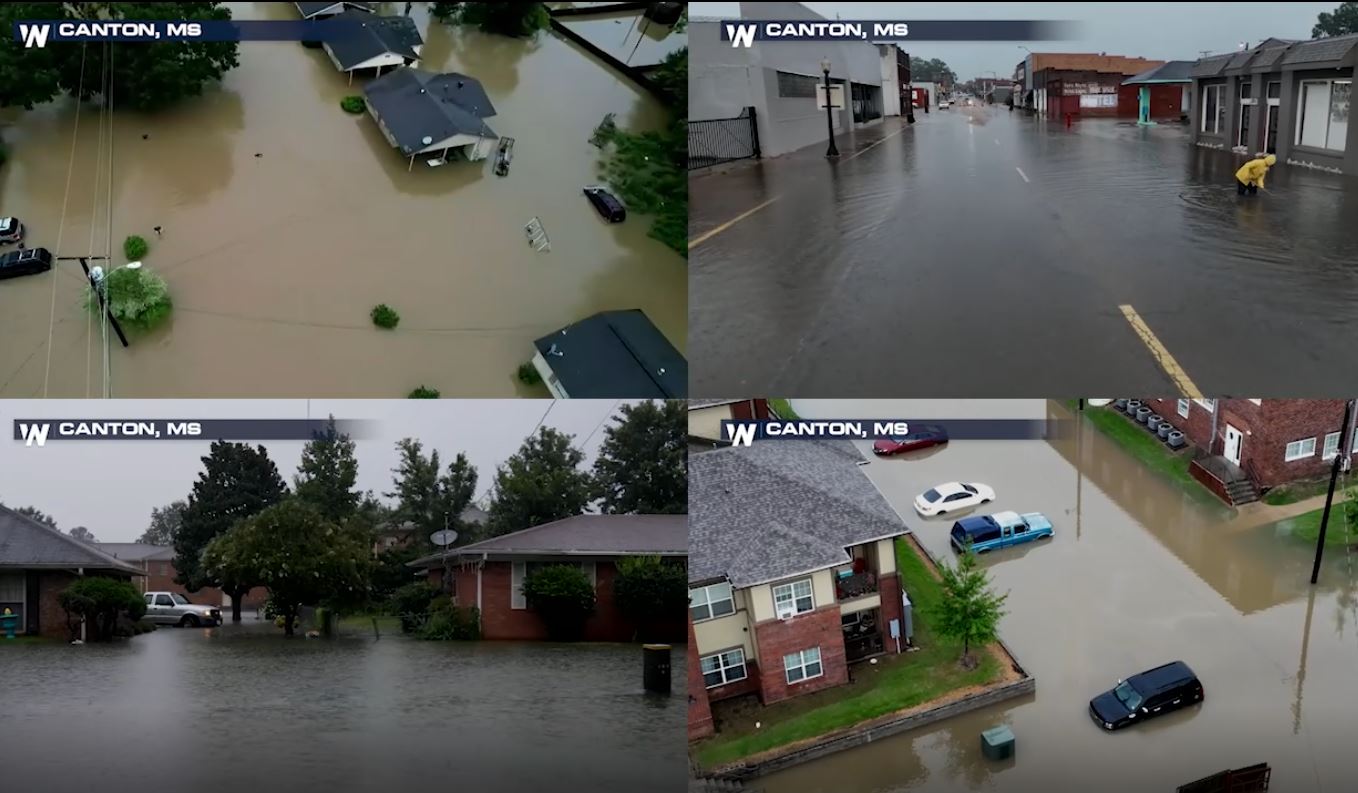Understanding Flash Flood Emergencies: A Complete Guide

Table of Contents
Understanding the Causes of Flash Floods
Flash floods are triggered by a variety of factors, all culminating in a rapid influx of water exceeding the capacity of the land to absorb it.
Intense Rainfall
Intense rainfall in short periods is the most common cause of flash floods. Heavy downpours saturate the ground, rendering it unable to absorb further water. Inadequate drainage systems in urban areas exacerbate the problem, leading to rapid accumulation of water on the surface.
- Weather Systems: Thunderstorms, particularly those associated with slow-moving weather systems or training thunderstorms (where successive storms repeatedly hit the same area), are major contributors. Hurricanes and tropical storms can also unleash torrential rain, leading to widespread flash flooding.
- Geographical Areas: Areas with steep slopes, poor drainage, and limited vegetation are particularly susceptible. Many mountainous regions and urban areas with significant impervious surfaces (like pavement) experience frequent flash flood events.
Dam or Levee Failures
The failure of dams or levees can release enormous volumes of water in a short time, causing catastrophic flash floods downstream. This is often exacerbated by intense rainfall preceding the failure, saturating the ground and overwhelming any remaining capacity of the river system.
- Historical Examples: Numerous historical flash floods have been directly attributed to dam or levee failures, highlighting the devastating consequences of inadequate infrastructure maintenance.
- Infrastructure Integrity: Regular inspection, maintenance, and timely upgrades of dam and levee systems are crucial to mitigating this risk. Proper monitoring systems are also essential to detect potential weaknesses before they lead to catastrophic failures.
Sudden Snowmelt
In mountainous regions, rapid snowmelt, particularly when combined with heavy rainfall (a phenomenon known as "rain-on-snow"), can trigger flash floods. The sudden release of large volumes of meltwater overwhelms rivers and streams, resulting in rapid and dangerous flooding.
- Influencing Factors: A rapid increase in temperature, coupled with rainfall, dramatically accelerates snowmelt. The amount of snowpack, the rate of melting, and the topography of the land all play significant roles in determining the flood's severity.
- Geographical Locations: Mountainous areas with significant snowpack, particularly during spring thaws, are prone to snowmelt-induced flash floods. Areas with limited vegetation to help retain water are especially vulnerable.
Identifying Flash Flood Risks in Your Area
Understanding the potential for flash floods in your specific area is critical for preparedness.
Recognizing High-Risk Zones
Certain geographical features significantly increase the risk of flash flooding. Being aware of these characteristics can help you assess your own vulnerability.
- Vulnerable Land Features: Areas near rivers and streams, low-lying areas, canyons, and mountainous regions with steep slopes are particularly susceptible. Areas with a history of flash flooding are at higher risk.
- Flood Risk Maps: Consult flood risk maps provided by FEMA (Federal Emergency Management Agency) in the US, or equivalent agencies in other countries, and your local government websites. These maps identify areas with a high probability of flooding.
Understanding Warning Signs
Recognizing the warning signs of an impending flash flood can be life-saving. Immediate action is vital once these signs appear.
- Immediate Warning Signals: Rapidly rising water levels, unusually murky or discolored water, strong and swift currents in normally calm waterways, and overflowing rivers or streams are all critical indicators.
- Heeding Alerts: Pay close attention to weather alerts and advisories issued by national meteorological services. These warnings often provide crucial information about impending flash flood risks. Immediate action based on these warnings is crucial.
Preparing for and Responding to Flash Flood Emergencies
Proactive planning and immediate action during a flash flood are essential to ensuring safety.
Developing a Preparedness Plan
Creating a comprehensive family emergency plan is vital. This plan should include specific strategies for flash flood situations.
- Emergency Kit Essentials: Your kit should include potable water, non-perishable food, first-aid supplies, medications, flashlights, a battery-powered radio, extra batteries, important documents in waterproof containers, and warm clothing.
- Evacuation Plan: Identify multiple evacuation routes from your home and workplace. Establish a designated meeting point outside the flood zone for family members to gather. Practice your evacuation plan regularly.
Emergency Actions During a Flash Flood
If a flash flood warning is issued or you observe warning signs, immediate action is crucial.
- Immediate Actions: Evacuate immediately if instructed to do so. Move to higher ground. Never attempt to drive or walk through floodwaters; even a few inches of fast-moving water can sweep a person or vehicle away. Contact emergency services if needed.
- If Trapped: If trapped by floodwaters, try to reach higher ground. If you are in a vehicle, abandon it and seek higher ground immediately. If you cannot evacuate, seek refuge on the highest level of a sturdy building.
Post-Flood Actions
Following a flash flood, safety and recovery efforts are vital.
- Post-Flood Safety: Check for structural damage before re-entering your home. Be aware of downed power lines and other hazards. Use caution when cleaning up; contaminated water can pose health risks.
- Recovery Resources: Contact your insurance company to report damages. Seek assistance from local authorities and relevant agencies for post-flood support and recovery programs.
Conclusion
Flash floods are unpredictable and dangerous natural disasters. Understanding their causes, recognizing high-risk areas, and developing comprehensive preparedness and response plans are crucial for protecting yourself and your community. The unpredictable nature of flash floods demands constant vigilance and proactive measures. Don't be caught unprepared. Learn more about flash flood emergencies today and protect your family by creating a comprehensive flash flood emergency plan for your household and sharing this vital information with your loved ones. Staying informed and prepared is your best defense against this devastating natural hazard.

Featured Posts
-
 Tik Tok Tourism Backlash Amsterdam Residents Sue Over Snack Bar Crowds
May 25, 2025
Tik Tok Tourism Backlash Amsterdam Residents Sue Over Snack Bar Crowds
May 25, 2025 -
 Ferrari 296 Speciale Apresentacao Do Motor Hibrido De 880 Cv
May 25, 2025
Ferrari 296 Speciale Apresentacao Do Motor Hibrido De 880 Cv
May 25, 2025 -
 Southern Vacation Destination Addresses Safety Concerns Following Shooting
May 25, 2025
Southern Vacation Destination Addresses Safety Concerns Following Shooting
May 25, 2025 -
 Understanding Flash Flood Emergencies A Complete Guide
May 25, 2025
Understanding Flash Flood Emergencies A Complete Guide
May 25, 2025 -
 Dopady Hospodarskeho Poklesu H Nonline Sk O Prepustani V Nemecku
May 25, 2025
Dopady Hospodarskeho Poklesu H Nonline Sk O Prepustani V Nemecku
May 25, 2025
Latest Posts
-
 Alex De Minaurs Madrid Open Exit Straight Sets Defeat And Swiateks Victory
May 25, 2025
Alex De Minaurs Madrid Open Exit Straight Sets Defeat And Swiateks Victory
May 25, 2025 -
 Grand Slam Debut Alex Eala Set For Paris
May 25, 2025
Grand Slam Debut Alex Eala Set For Paris
May 25, 2025 -
 Ealas Grand Slam Debut In Paris A Look Ahead
May 25, 2025
Ealas Grand Slam Debut In Paris A Look Ahead
May 25, 2025 -
 Naomi Campbells Future At The Met Gala Uncertain Amid Wintour Dispute
May 25, 2025
Naomi Campbells Future At The Met Gala Uncertain Amid Wintour Dispute
May 25, 2025 -
 Naomi Campbells Potential Met Gala 2025 Absence The Anna Wintour Conflict
May 25, 2025
Naomi Campbells Potential Met Gala 2025 Absence The Anna Wintour Conflict
May 25, 2025
